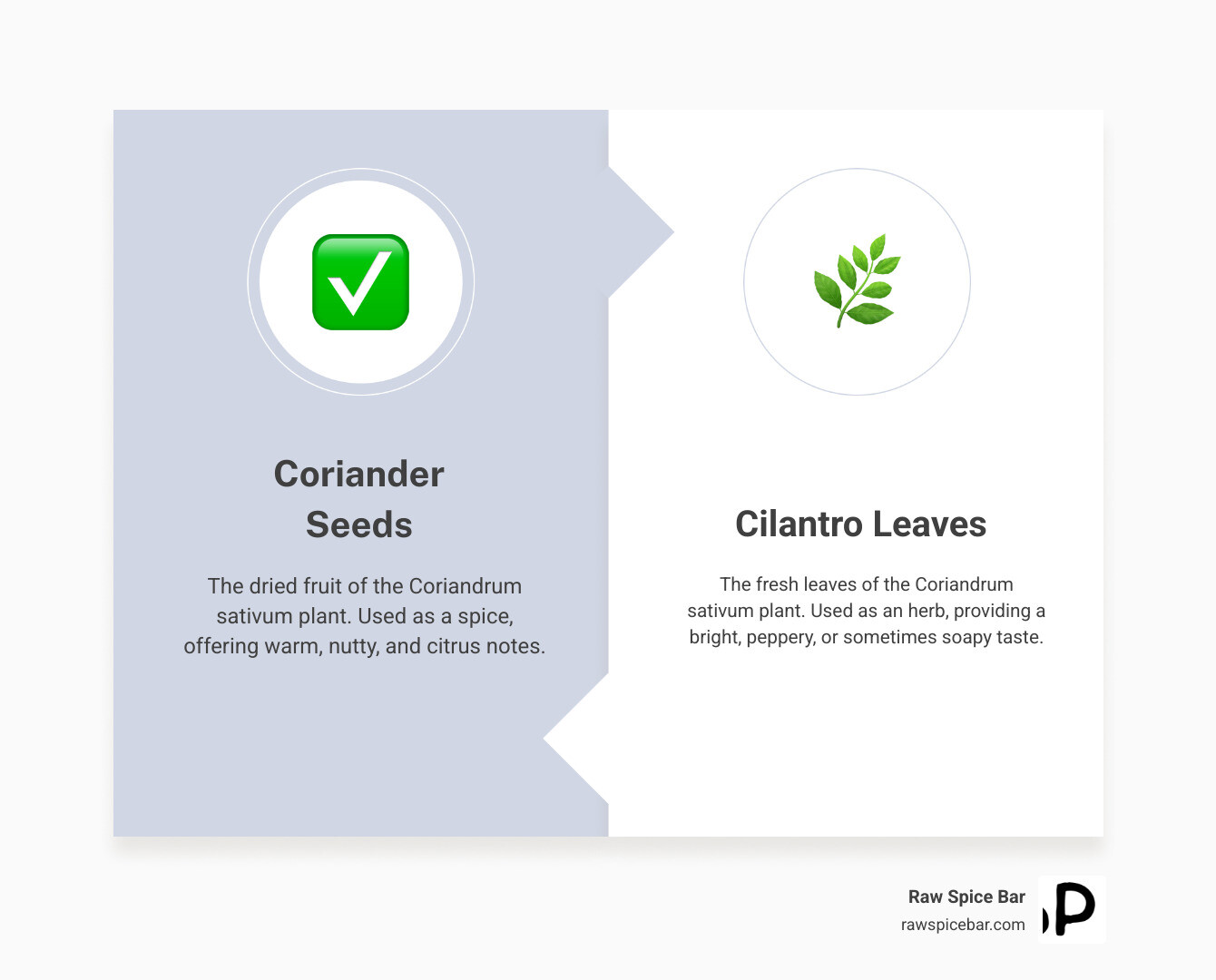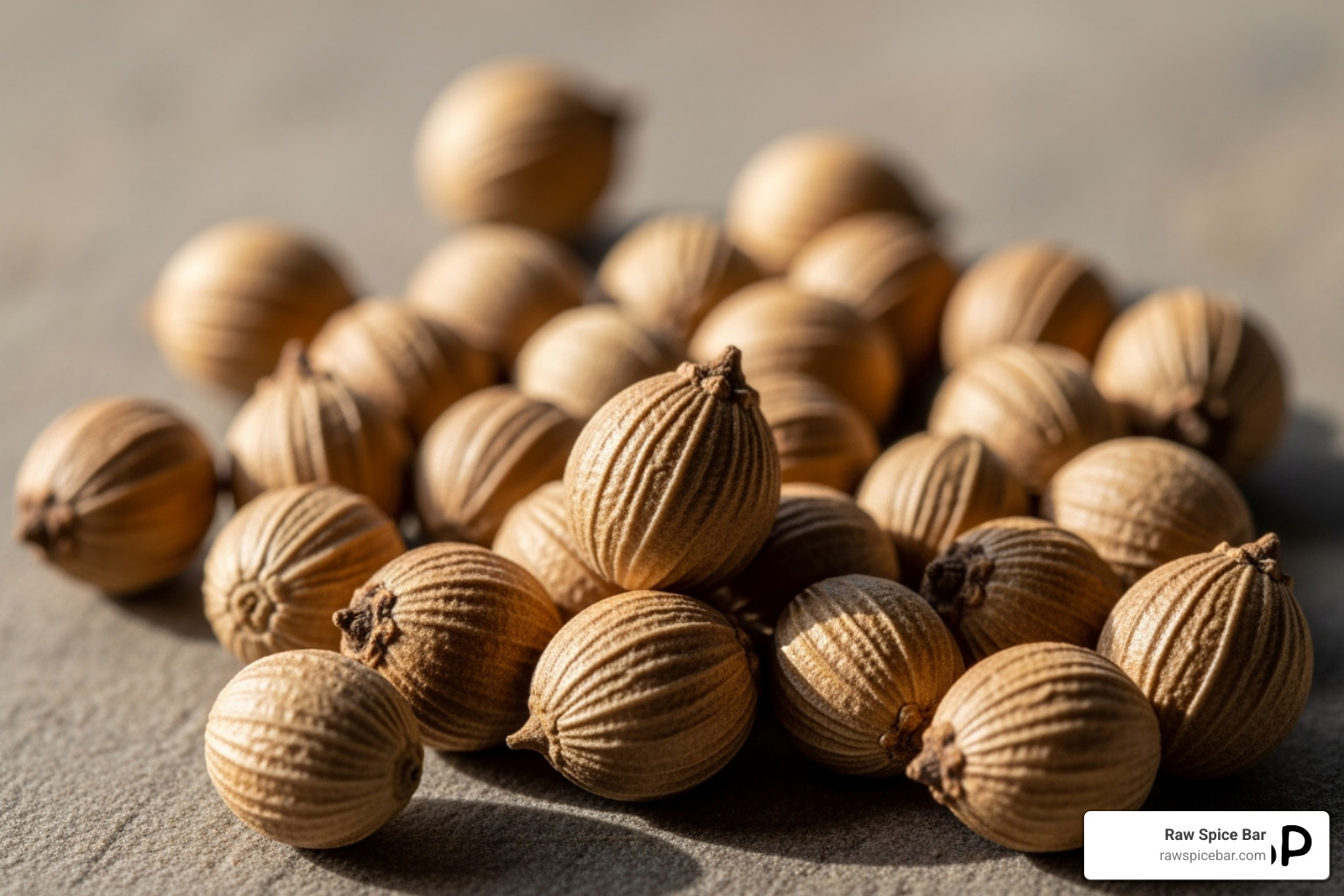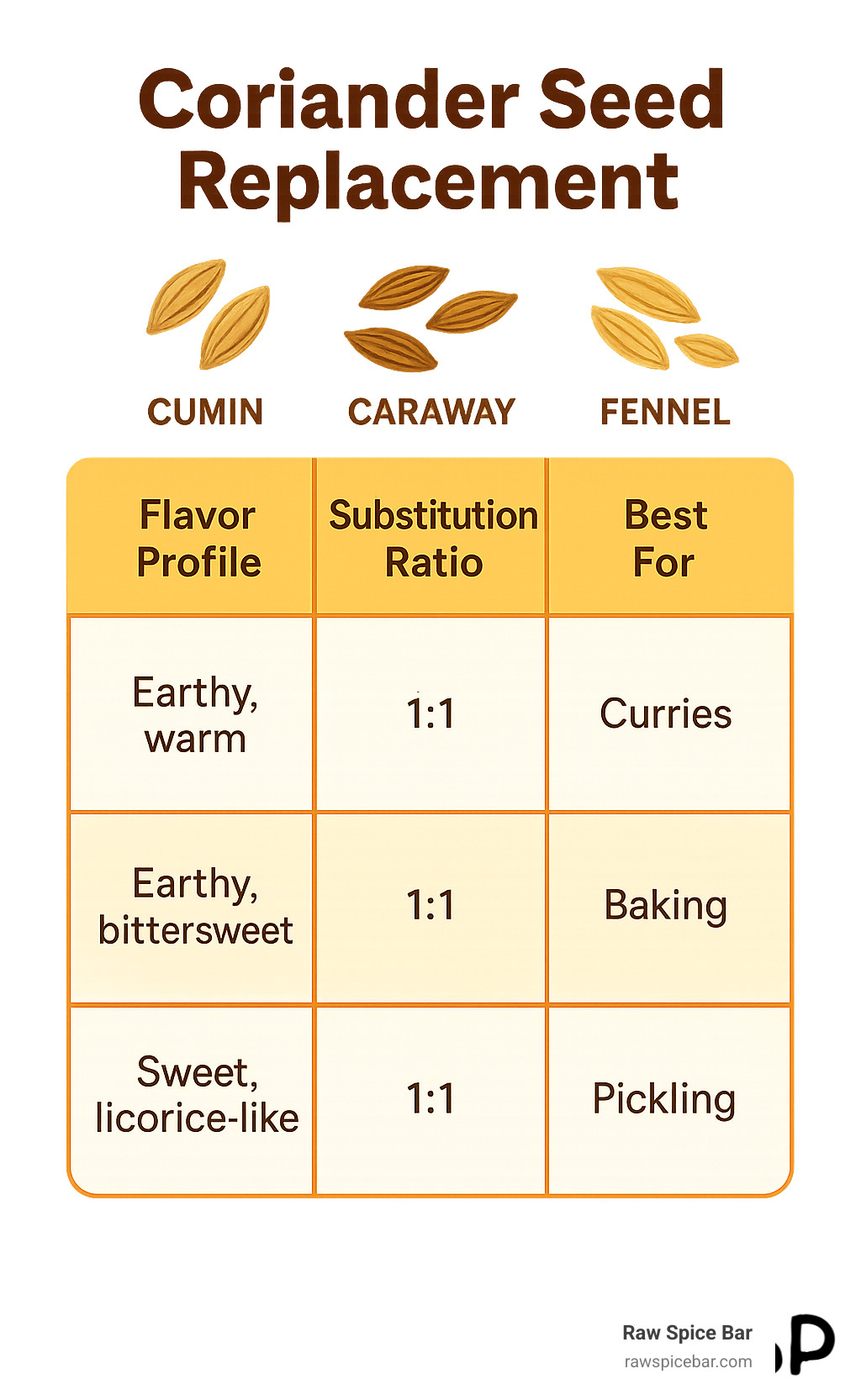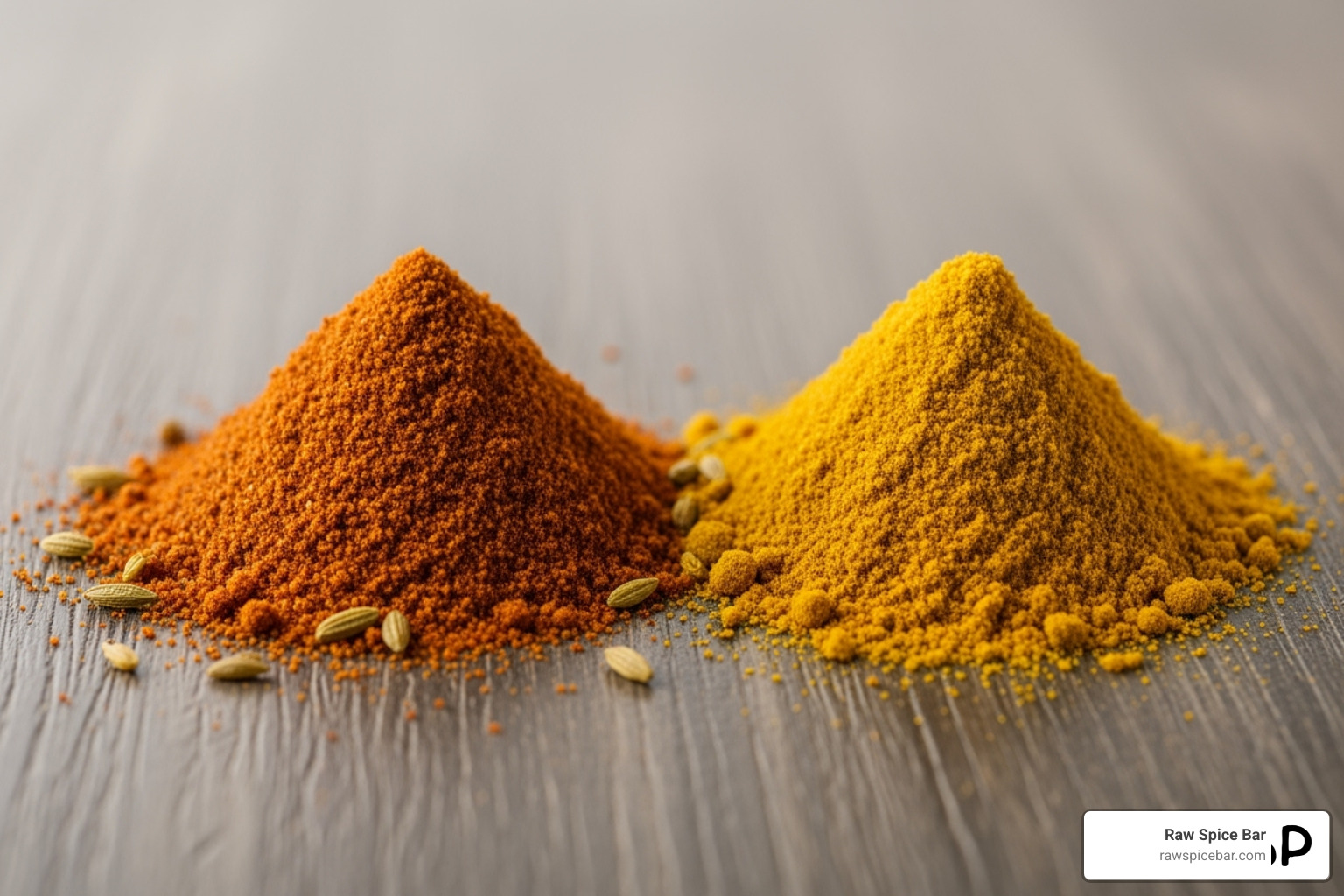That Moment You Realize a Key Spice is Missing
Coriander seed replacement becomes urgent when you're halfway through cooking and find your spice jar is empty. Whether you're making a curry, pickling vegetables, or following a new recipe, running out of this essential spice can derail your cooking plans.
Quick Answer - Best Coriander Seed Substitutes:
- Cumin - Use 3/4 the amount, earthy and warm
- Caraway seeds - 1:1 ratio, aromatic with anise notes
- Fennel seeds - Start with half the amount, sweet and mild
- Garam masala - Contains coriander, use sparingly
- Curry powder - Another blend option, adds color
Picture this: It's cold, rainy, and you're stuck inside making chili. You reach for your coriander seeds and find nothing but an empty jar. This common kitchen predicament has plagued home cooks for generations.
Coriander seeds have been treasured from India and China to the Middle East since early history. They've even been found in old Sanskrit writings and early Egyptian tombs. Today, these small brown seeds remain essential in global cuisines from Mexican salsas to Indian curries.
The good news? Several spices can step in when coriander seeds go missing. Each substitute brings its own flavor profile, but with the right ratios and techniques, you can keep cooking without missing a beat.
I'm Joseph Rosenblatt, and through years of developing spice blends and helping customers steer coriander seed replacement challenges, I've learned which substitutes work best for different dishes. My experience sourcing global spices has shown me that understanding these alternatives can actually expand your cooking repertoire beyond what you originally planned.

Simple guide to coriander seed replacement terms:
Understanding Coriander: Seeds, Ground, and Leaves (Cilantro)
Before we explore coriander seed replacement options, let's clear up one of cooking's most confusing plant families. Meet Coriandrum sativum - a single plant that somehow manages to create two completely different flavors depending on which part you use.
This member of the Apiaceae family (think carrots, parsley, and celery) has caused kitchen confusion for generations. In the US, we call the dried seeds "coriander" and the fresh leaves "cilantro." But travel to the UK, and suddenly "coriander" might mean the leaves while "coriander seed" specifically refers to the spice. No wonder recipes can feel like riddles sometimes!

Coriander seeds offer a completely different experience than their leafy counterparts. These small brown seeds deliver warm, nutty, and earthy flavors with subtle citrus notes that make them incredibly versatile. When you crush them, essential oils like linalool and pinene release that distinctive lemony aroma that transforms curries, pickles, and baked goods.
The beauty of coriander seeds lies in their gentle nature. You can use them generously without overwhelming a dish. They play beautifully with garlic and chili, complement lamb and pork perfectly, and add depth to everything from Indian cuisine to Middle Eastern stews. Use them whole for pickling or grind them fresh for maximum flavor impact.
Cilantro leaves tell a completely different story. These bright green leaves burst with peppery, citrusy flavors that work best as finishing touches. Unlike the seeds that build foundational flavors, cilantro wilts quickly under heat and loses its vibrant character.
Here's where genetics gets interesting. Some people taste cilantro as fresh and bright, while others swear it tastes like soap. This isn't pickiness - it's actually a genetic variant near olfactory receptor genes that influences how we perceive cilantro's flavor compounds.
This flavor difference explains why seeds and leaves aren't interchangeable in recipes. You can't substitute fresh cilantro for coriander seeds and expect the same warm, earthy foundation. The textures, cooking applications, and flavor profiles are completely different - which is exactly why we need good coriander seed replacement options when our spice jar runs empty.
If you're looking specifically for cilantro alternatives, check out our complete cilantro replacement guide for fresh herb substitutions that actually work.
The Best Single-Spice Swaps for Coriander Seeds
When you need a coriander seed replacement quickly, single spices are your best friends. They're straightforward, you probably have them in your pantry already, and they won't complicate your recipe with unexpected flavors. The trick is understanding which ones work best for different dishes.
Think of it like finding a good friend to fill in when you can't make it to dinner. You want someone who'll fit in naturally, not completely change the conversation. These three spices are your most reliable stand-ins.

Cumin: The Warm & Earthy Go-To
If coriander seeds had a best friend in the spice world, it would be cumin. They show up in the same cuisines, they both love hanging out with garlic and chili, and they share that warm, earthy personality that makes savory dishes sing.
Here's the thing about cumin though - it's the louder friend. Where coriander is gentle and nutty with those pleasant citrus notes, cumin comes in with more intensity. It's earthier, slightly bitter, and has a pungent aroma that can take over if you're not careful.
For your substitution ratio, use 3/4 the amount of cumin compared to coriander. So if your recipe calls for 1 teaspoon of coriander seeds, start with 3/4 teaspoon of cumin. You can always add more, but you can't take it back once it's in there.
Want to make your cumin shine? Toast the whole seeds in a dry pan for a few minutes before grinding or adding them to your dish. This simple step brings out nutty undertones that make cumin an even better coriander seed replacement.
Cumin works beautifully in curries, soups, stews, and roasted vegetables - basically anywhere you need that warm, foundational flavor. It's particularly excellent in heartier dishes where its robust character can stand up to other bold ingredients.
For a deeper understanding of how these two spices play together (and apart), check out our guide on Cumin vs. Coriander: Decoding Unique Flavors and Culinary Harmony.
Caraway Seeds: The Aromatic Relative
Here's a fun fact: caraway seeds are actually from the same plant family as coriander. They're like cousins who share some family traits but have their own distinct personalities. This family connection makes caraway a natural coriander seed replacement.
Caraway brings earthy and nutty notes similar to coriander, but with a twist - it has these lovely anise and licorice hints that add complexity to dishes. It's more aromatic and pungent than coriander, so a little goes a long way.
You can use caraway seeds as a 1-to-1 replacement, but start conservatively. Those anise notes can be quite pronounced, especially if you're not used to them. If you're making something like rye bread or sauerkraut, caraway actually might be better than the original coriander called for.
The key with caraway is knowing where it shines. It's fantastic in rye bread, savory casseroles, and hearty stews where that slight licorice sweetness complements other ingredients rather than competing with them.
For more practical substitution ideas, explore our comprehensive Cooking Without Coriander: The Ultimate Substitute Spice Guide.
Fennel Seeds: A Sweet & Aromatic Alternative
Fennel seeds are the gentle option when you need a coriander seed replacement with a touch of sweetness. They have that mild licorice taste that's much softer than anise or even caraway, plus sweet notes that can actually improve certain dishes.
Think of fennel as the diplomatic substitute. It won't try to replicate coriander's exact flavor profile, but it brings its own pleasant complexity that works especially well in Mediterranean dishes.
Start with half the amount of fennel seeds compared to what your recipe calls for in coriander. Fennel's flavor can be quite distinct, and it's better to add more gradually than to overwhelm your dish with that sweet anise character.
Here's a pro tip: crush the fennel seeds lightly before adding them to your recipe. This releases their aromatic oils and helps them integrate more smoothly into your dish rather than hitting you with bursts of concentrated flavor.
Fennel seeds work beautifully in Mediterranean dishes, sausages, soups, and when roasting vegetables. They're particularly good with root vegetables where their sweetness can balance earthier flavors.
Using Spice Blends as a Coriander Seed Replacement
Sometimes you need to think beyond individual spices. When you're searching for coriander seed replacement options, your spice cabinet might already hold the perfect solution in the form of pre-made blends. These complex mixtures often contain coriander as a key ingredient, making them surprisingly effective substitutes.
The beauty of using spice blends lies in their convenience and complexity. Since coriander is already woven into their flavor profile, you're getting some of that familiar taste you're missing. But here's the thing – these blends are like getting a whole orchestra when you only asked for a violin solo. They'll bring additional flavors and, in some cases, vibrant colors that can completely transform your dish.
Before reaching for any blend, take a moment to check the ingredients list. If your recipe already calls for cumin, cardamom, or other spices that feature prominently in the blend, you'll want to dial back those individual spices to avoid creating a flavor traffic jam. Start with less than you think you need, taste as you go, and adjust gradually.
These blends work best when you're cooking "in a pinch" or when you actually want to steer your dish toward a broader, more complex flavor profile. They're particularly useful when you're already working within the same cuisine family as the blend.

Garam Masala
Think of Garam Masala as the warm hug of the spice world. This traditional Indian blend literally translates to "warm spice mix," and it lives up to its name with an aromatic, complex flavor that can make any dish feel more comforting.
Cumin, cardamom, cinnamon, and cloves typically join coriander in this fragrant blend, though recipes vary from region to region and family to family. Coriander often serves as a foundational ingredient, providing that earthy, slightly sweet base that holds everything together.
When you use Garam Masala as a coriander seed replacement, you're not just getting coriander's flavor – you're inviting the whole spice family to dinner. The cardamom adds floral sweetness, while cloves bring their distinctive warmth. This means your dish will develop a distinctly Indian character, which can be wonderful if that's where you want to go.
This blend shines brightest in Indian dishes, curries, and lentil preparations where its full, rich complexity can complement rather than compete with other ingredients. It's less ideal for delicate dishes where coriander was meant to play a subtle supporting role.
For budget-conscious cooks looking for alternatives, our guide on 5 Cheaper Alternatives to Coriander Substitute Spice offers practical solutions.
Curry Powder
Curry powder is the chameleon of spice blends – it changes dramatically depending on who made it and where. What remains consistent is that coriander almost always plays a starring role in its composition, making it a reliable coriander seed replacement option.
Most curry powders feature turmeric, fenugreek, ginger, and various chilies alongside coriander. The turmeric is particularly important to note because it will paint your dish a brilliant yellow color. This can be delightful in some preparations but might not be what you're after if you're making something like a cream sauce.
The flavor impact goes well beyond just replacing coriander. You're introducing a complex symphony of tastes that will give your dish a distinctive "curry" personality. The intensity can range from mild and sweet to bold and fiery, depending on the specific blend you choose.
Curry powder works beautifully as a coriander seed replacement in stews, soups, and marinades where you can accept its transformative power. It's particularly useful when you're already working within Indian or Asian flavor profiles. However, if your recipe depends on coriander's subtle, citrusy notes, curry powder might be too bold and could dramatically alter your intended result.
Always start with a conservative amount and taste as you build the flavors. You can always add more, but you can't take it back once it's in there.
Frequently Asked Questions About Coriander Substitutions
We understand that navigating spice substitutions can bring up a lot of questions. Here, we tackle some of the most common queries we hear from home cooks looking for a coriander seed replacement, offering practical tips for cooking success.

Can I use ground coriander for whole seeds? (And vice-versa?)
Yes, absolutely! This is one of the most common and easiest substitutions to make, as ground coriander is simply the powdered form of the seeds. However, there are a few key differences to be aware of:
Flavor Potency and Shelf Life: Whole coriander seeds generally store much better and retain their flavor and aroma longer than ground coriander. Ground spices have a larger surface area exposed to air, light, and heat, causing their volatile oils to dissipate more quickly. This means an older jar of ground coriander might have lost much of its potency. Freshly ground seeds, on the other hand, will be much more aromatic and flavorful than pre-ground powder.
To use whole seeds for ground coriander: If your recipe calls for ground coriander but all you have are whole seeds, you're in luck! This is the ideal scenario for the best flavor. We recommend lightly dry-toasting the whole seeds in a pan for a few minutes until fragrant before grinding. This step significantly improves their aroma and makes them easier to grind.
Grinding Methods:
- Mortar and Pestle: This is our preferred method for small quantities, as it allows you to control the fineness of the grind and truly brings out the oils.
- Spice Grinder (or Coffee Grinder dedicated to spices): For larger quantities or a very fine powder, an electric spice grinder is efficient.
- Rolling Pin: In a pinch, you can place the seeds in a sturdy plastic bag and crush them with a rolling pin.
Substitution Ratio (Whole to Ground): A good general rule of thumb is that 1 teaspoon of whole coriander seeds will yield approximately 3/4 teaspoon of ground coriander. So, if your recipe calls for 1 teaspoon of ground coriander, start with 1 and 1/4 teaspoons of whole seeds, toast, and grind. Conversely, if your recipe calls for 1 teaspoon of whole seeds and you only have ground, use about 3/4 teaspoon of the ground powder. Remember to adjust to taste, especially if your ground coriander has been sitting in the pantry for a while.
Is fresh cilantro a good coriander seed replacement?
This is a question we get all the time, and the answer is a resounding no, not typically. While they come from the same plant, fresh cilantro leaves and dried coriander seeds have vastly different flavor profiles and culinary applications.
Flavor Difference: Coriander seeds have a warm, nutty, earthy, and citrusy taste when ground. Fresh cilantro, on the other hand, is bright, herbaceous, and peppery, with some people experiencing a "soapy" taste due to a genetic trait. They simply do not taste alike.
Texture Difference: Using fresh leaves in a dish that calls for dried seeds will also introduce a textural component that is likely not intended. Whole coriander seeds are often toasted and ground into a powder, meant to blend seamlessly into a sauce or rub. Fresh cilantro, with its delicate leaves, would wilt and likely become mushy if cooked for a long time.
Cooking Application: Coriander seeds are typically used as a foundational spice, often toasted and ground, to build the base flavor of a dish (e.g., in curries, rubs, or pickling liquids). Fresh cilantro is generally added at the very end of cooking, or as a garnish, to provide a fresh, vibrant burst of flavor and color. Its flavor diminishes significantly with heat, so it's not suited for long cooking processes where the seeds would be used.
When it might work (very rarely): In very specific, rare instances where a recipe calls for coriander seeds as a garnish or a very light, fresh, citrusy top note that isn't central to the dish's flavor, you might get away with a tiny sprinkle of fresh cilantro. But even then, it won't replicate the earthy warmth of the seeds. For the most part, we advise against using fresh cilantro as a coriander seed replacement.
What is the best all-around coriander seed replacement?
The "best" coriander seed replacement truly depends on the dish you're making and the specific flavor profile you're aiming for. There isn't a single, perfect 1:1 substitute that works for every single recipe, because coriander itself has a complex balance of earthy, nutty, and citrusy notes that are hard to replicate entirely.
However, based on versatility, flavor compatibility, and common availability, we can highlight our top recommendations:
- Cumin: This is often our go-to coriander seed replacement. Its strong earthy and warm notes make it suitable for a wide range of savory dishes, especially curries, stews, and chili. It provides that foundational depth that coriander offers.
- Caraway Seeds: If your dish can handle a hint of anise or licorice, caraway is an excellent choice. Being from the same family as coriander, it shares some underlying earthy characteristics. It's particularly good for bread, root vegetables, and savory European-style dishes.
- Fennel Seeds: For a sweeter, milder, and slightly licorice-flavored alternative, fennel seeds can work well. They are great in Mediterranean-inspired dishes, sausages, or anywhere a brighter, aromatic note is welcome.
When choosing your coriander seed replacement, consider the primary flavor role coriander plays in your recipe. Is it providing an earthy base? A hint of citrus? A warm aroma? Then pick the substitute that best matches that specific need. Don't be afraid to experiment, starting with smaller quantities and tasting as you go. Your palate is your best guide!
Conclusion: Never Let an Empty Spice Jar Stop You
That sinking feeling when you find an empty spice jar doesn't have to derail your cooking plans. As we've explored throughout this guide, finding the right coriander seed replacement is more about understanding flavors than finding a perfect match. With a few common spices in your pantry, you can confidently tackle any recipe that calls for coriander seeds.
Cumin remains our top recommendation for most situations. Its warm, earthy profile makes it incredibly versatile, especially when you're making curries, stews, or any dish where coriander provides that foundational depth. Just remember to use about three-quarters of what the recipe calls for and toast those seeds for maximum flavor impact.
Caraway seeds offer something special as coriander's aromatic cousin. That hint of anise might seem intimidating at first, but it works beautifully in savory dishes, breads, and anywhere you want to add complexity. Since they're from the same plant family, they share those underlying earthy notes that make coriander so valuable.
For dishes that can handle a touch of sweetness, fennel seeds bring a gentle licorice flavor that's particularly lovely in Mediterranean cooking. Their mild nature means you can experiment without overwhelming your dish.
Don't overlook spice blends like Garam Masala and Curry Powder when you're in a pinch. Since they already contain coriander, they're giving you some of that familiar flavor while adding their own complexity. Just be mindful of the additional colors and flavors they bring to the table.
The real magic happens when you start experimenting. Every kitchen trip teaches you something new about how flavors work together. Maybe you'll find that caraway seeds are perfect in your grandmother's stew recipe, or that a pinch of cumin transforms your roasted vegetables in an unexpected way.
Keeping a well-stocked spice pantry certainly helps, but knowing your options when ingredients go missing is what separates confident cooks from panicked ones. At Raw Spice Bar, we believe that every home cook should have access to fresh, globally inspired spices that open up new culinary possibilities.
Ready to expand your spice horizons? Find new global flavors with a spice subscription and never worry about running out of essential spices again.




